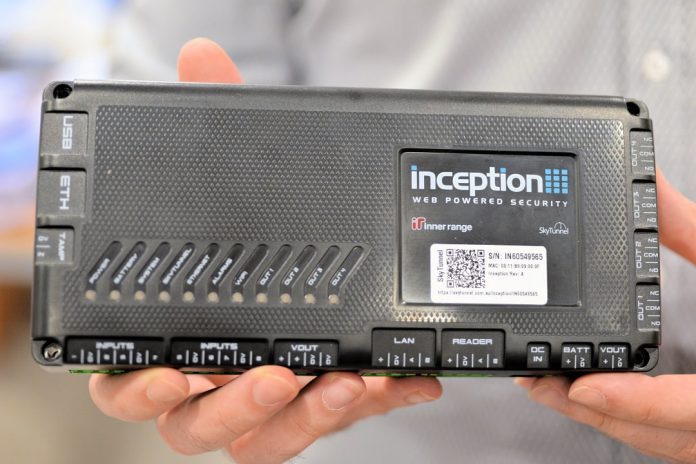What’s the ideal solution for the smaller business? While such solutions may not need to incorporate some elements of enterprise functionality, SMEs benefit from the enhanced functionality and value expanded return on investment.
ACCORDING to Stuart Harmer of ISCS, the perfect access control solution for SMEs is balanced, offering a strong feature set and minimising complexity for integrator and end users. Another key element is no-fuss networking capability.
“I think the perfect access control system is one that takes very little technician programming and works on the internet out of the box,” Harmer says. “Access systems need to combine intrusion, access control, the integration of some CCTV and some level of building automation, most of the hard programming work needs to be already done by the manufacturer, leaving simple programming wizards for the installer. This will speed up the installation and provide a more complete system.”
Given that many smaller security access control solutions now include automation capability and remote management, Harmer argues SMEs and installers of SME systems should be focusing on programming totally via an app or web browser, with simple programming wizards.

“Core considerations for smaller users include the flexibility to use any of the card readers or biometric readers available in the marketplace,” Harmer says. “If a system only works with a proprietary reader, I think this is too limiting. When it comes to reader technology, biometric readers are now cost effective and offer exceptional false rejection rates.”
Harmer believes the latest generation of capable compact access control solutions is giving users a level of low cost performance they have never had before.
“Yes definitely,” he says. “Take our ProtegeWX system for example. This powerful little controller can start off at one door and can be expanded up to 128 doors. It has a network connection on board along with 2 wiegand reader ports, 8 alarm inputs and outputs for door locks and sirens. Programming is via a web browser, so no software is required to be loaded. All of this for well under $A1000 is unheard of, but with ProtegeWX it’s a reality.”
For Steve Mitchell, Inception project lead Inner Range, the perfect access control system for an SME is easy.
“A perfect system for a typical SME, in addition to intrusion detection, access control and remote management, is one that focuses on ease of use for both the end user and the installer,” Mitchell explains. “Having an access control system that is accessible and intuitive for the end user allows more of the features of the system to be leveraged by the SME.”

Additionally, SMEs benefit significantly by having a system with automation capabilities. Automation provides installers with the ability to provide flexible and tailored solutions for their customer.
“Combining the configuration software for the system with the controller hardware, such as an inbuilt web interface, provides significant benefits for an SME. They gain a fully integrated solution with a feature rich user interface without requiring additional computer hardware and software to be installed and maintained.
“Another important aspect of the perfect access control system is scalability. Often the actual size of an SME installation will not be realised until the solution has been installed and used. A modular system that can easily be expanded provides the SME with a solution that can grow as their business grows.”
When it comes to functionalities, Mitchell says installers and SMEs should be focusing on things like remote management, among other things.
“The inclusion of these features allows both the SME and the installers of SME to gain a lot more value and convenience beyond a typical intruder and access control solution,” Mitchell says. “Installers can provide a tailored solution for their client and the SME gains a system that supports and enhances their day to day activities.
“Remote management capabilities, especially from internet-connected devices like smartphones, allow the system to be controlled from any location. Installers can perform remote maintenance from the side of the road if required and can utilize system related notifications to be proactive in the ongoing maintenance of the site. End users are able to interact, manage users and control their system from any device which gives greater convenience and sense of trust in the system protecting their business.”
For Mitchell, enhanced automation capabilities allow the system to manage more than just the security and access requirements of the site.
“Many different responses can occur from a single card swipe, beyond the door unlocking,” he says. “Business practices and policies for an SME involving custom requirements and especially those that relate to safety can also be enforced by the system. Simple automation can ensure that when a forklift is in use, visual indicators are activated and a user’s access to the area is restricted, reducing the risk of employee injuries.
“Integrating the system with a building management system can provide significant ongoing benefits to the SME. The cost of running a business can be reduced when automation can control lighting and HVAC systems, as these systems do not need to be running in a room that is secure or where no users are located.”

So, what can SME systems not do without?
“As a core consideration, the access control system cannot do without easy user management for the SME,” Mitchell explains. “Often, on smaller sites, there is no dedicated security manager so the role of adding or removing users shifts from one employee to another. Given this, it’s critical that the system is intuitive to use, requires little training and even guides the employee through the process of creating a user.
“The access control system should also have integration with the intruder detection system. Security is always a requirement for an SME, so having a single system that provides both the access control and intruder functionality offers many convenience features and also reduces the number of systems with which a small site needs to interact.
“Remote control and management abilities are now almost an expected requirement of modern access and security systems. In addition to remote management, remote control gives the user convenient command over their system. Control of doors becomes a key feature when a user forgets their access card, while area control lets the user verify that they locked up correctly when they are halfway home.”
Mitchell agrees biometric readers are viable for SMEs at this point in time, given they simplify credential management and save money over time.
“Yes, additionally biometrics also provide a credential that cannot be lost or stolen,” he says. “Modern access control systems allow the user to be assigned more than one credential enabling biometric readers to be used in conjunction with traditional readers making the solution more viable for SMEs.”
According to Mitchell, the basic requirements of an access control systems have changed very little over the years. However, he says the latest generation of access control systems provides many convenience features.
“Previous generation products required dedicated computer hardware and software for local system management,” Mitchell points out. “In contrast, modern systems include on-board web interfaces that can easily be accessed remotely and securely over the internet. The latest generation of access control systems have had more emphasis placed on simplicity and ease of use resulting in a system that is more accessible to end users. As a result, SMEs have a greater sense of ownership and control of their access control systems. SMEs also benefit by the inclusion of features previously only found in enterprise level solutions such as remote control from a smartphone, notifications of events and system reports.”
According to Chris Fitzpatrick of CS Technologies, the perfect access control system for SMEs will have simple software programming, in particular an easy to use program step covering users, time zones, locations – doors, lift floors, etc.
“Uncomplicated integration of other requirements such as alarms, air conditioning control, lighting control, parking control, CCTV systems, low cost main board with daughter-board expansion is also important,” Fitzpatrick says. “And all this must be achieved using access control boards that are fully independent from the software – i.e. fully distributed memory storage of users, timezones, doors, transaction history to reduce the risk of outside hacking and interference. A perfect access solution will also be resilient to power and static issues to reduce the chance of memory corruption and loss of programme data on the board.”

Given many smaller security access control solutions now include automation capability and remote management, where does Fitzpatrick think SMEs and installers of SME systems should be focusing when it comes to functionalities?
“Energy management of the SME site via the use of the access control system to control not only the security and integrity of the site but the consumption of power when areas of the site are not being used is a big area of potential,” Fitzpatrick says. “This could be achieved by the use and integration of a combination of access control, movement and temp sensors to reduce the growing costs of power for SMEs.
“Other core considerations would be ease of use, given that not all end users are engineers, so the system must be able to be programmed by the client to make changes to the system. Flexibility of design is important, too. Can the system expand to meet increased demands on security, staff numbers both at the local site and other remote sites, environmental requirements and more?”

Unlike the others, Fitzpatrick is a little chary of biometric access control readers.
“I’m not a big fan, as a secure system would be expansive and the per door cost usually exceeds expectations by the client,” he explains. “The cheaper systems don’t read the finger print to a higher percentage and there are other alternatives such as the use of the plastic FOB with a usage of 5 to 8 years, mobile phone technology as the identity and for very secure points of access the combination of reader and CCTV camera to confirm the user.
“While the latest generation of access control systems offers additional capabilities to end users and installers, it should be remembered the per-door cost for the installation of the reader and locking device will be the same no matter how expensive the controller board and software are. Again, the performance will depend on how smart the controller. Taking that into account, there’s no doubt most of the capable compact access control solutions offer a great deal more functionality than the solutions of 5 years ago.”












